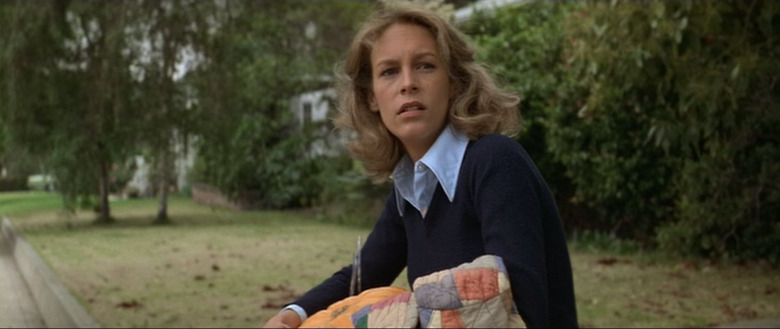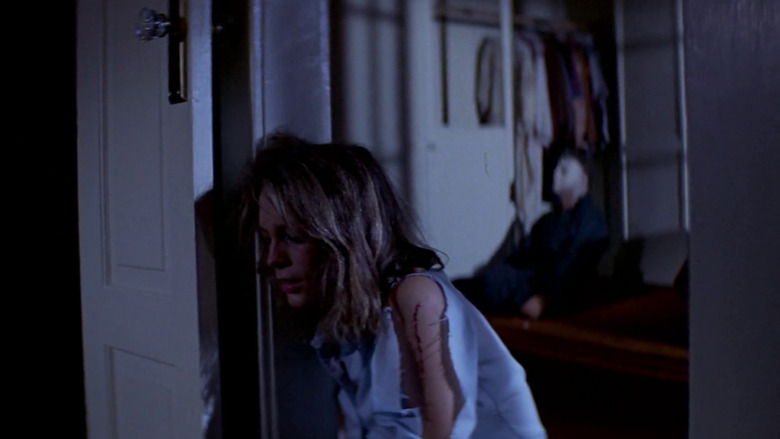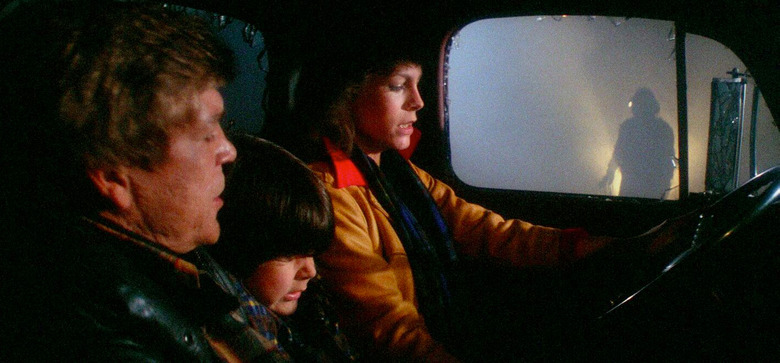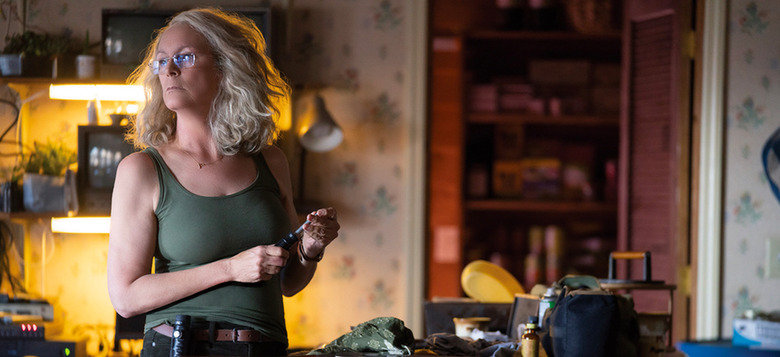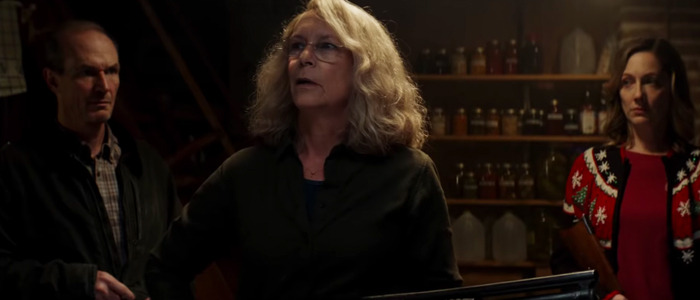Charting The Career Of Jamie Lee Curtis From Strode To Strode
(Welcome to Role Call, where we examine two performances from an actor – their first defining role and their most recent/last – to get a sense of who they are.)Jamie Lee Curtis has always been fascinating because of her contradiction. As the daughter of Tony Curtis and Janet Leigh, she could have been the poster child for Hollywood nepotism, but she became an actor of the people.
Even though she describes her dad as becoming a post-divorce absentee parent when she was really little, and we can't really quantify these things with a graphing calculator or anything, it's still no stretch to assume that her mom's status gave her a foot in the acting door. Advice, guidance, a little nudge. The benefit of being on backlots throughout an entire childhood.
But Curtis didn't take the royal red carpet path to easy fame. She leaped out of obscurity with a clang and violin screech inside the flimsy, uncertain walls of indie horror. By the time he rounded up a crew for his low budget horror film, John Carpenter had made a low budget sci-fi comedy, a low budget exploitation action flick, and a low budget thriller, so it couldn't have been clear that Curtis was hitching her wagon to a rocket ship even though the resulting creative relationship was explosive.
Curtis stuck with the genre for years, and has admirably stuck with the Halloween franchise itself even through its most heinous incarnations.
Beyond Horror
Curtis is a Renaissance Woman. Actor, inventor, author, philanthropist, charming yogurt enthusiast. She's also a Baroness through her marriage to Christopher Guest, although you'd never know it without reading her bio. She refuses to project both the aura of Hollywood royalty or the literal kind.
That image falls in line with the crowd-pleasing roles she's always taken on. She reunited with Carpenter for The Fog, reprised her role for Halloween II, and hung around low budget slashers long enough to become the face and name of tied to the genre's 1980s resurgence.
Then she pivoted to comedy.
Trading Places gave her both the opportunity to work for a major studio and to stop running from knife-wielding maniacs. It set her on her twin tracks – broad, likable studio fare like A Fish Called Wanda and True Lies, and a career-long commitment to Halloween.
Her Early Role: Laurie Strode in Halloween
Halloween wasn't the first slasher movie, but it congealed the newer elements into something artistic and successful enough to copy until our senses deadened. As a product of the late 1970s, it blended the soap opera morality tales of the 1950s with the lust of Hitchcockian exploitation. Like Reefer Madness with a kill streak.
Curtis played Strode – the virginal survivor – with a competing edge of awareness and maturity. Her friends were doing grown-up stuff (that thematically got them gutted), but Strode was always somehow older. Keen without being paranoid. A kid with instincts. Her survival came with a high price.
It's funny to look back at how many reviews at the time compared the film to Psycho (for good and bad) without vocalizing that Curtis's mother had been its star. Fortunately it didn't keep most critics from recognizing that Curtis was the main reason the movie worked. Washington Post critic Gary Arnold described Curtis as a "melancholy, ungainly young Lauren Bacall," which I'm pretty sure was meant as an insult, but echoes the excellent quality of youthful awkwardness matched with ephemeral adulthood I just described. Ebert raved about the film's terror, crediting Carpenter for the mood and for crafting characters that are all everyday, recognizable people, but stopping short of name-checking Curtis for giving us the perfect entry point to the nightmare. She holds our hand the entire film, and eventually we want to squeeze hers even tighter.
The Persona: Queen of Screams
It's not surprising that Curtis followed up Halloween with its sequel and several other forays into Final Girl territory. The seminal slasher's full influence on the genre wouldn't be fully realize until years and years later, but it's slow-building success gave her more room to run, so it's strange to recognize that a linchpin of a legendary movie followed it up with more low budget screaming.
At the time, Curtis said, "I don't know if I'd want a huge rise real quick. I feel the biggest problem with this business is that people have stopped feeling lucky and think they deserve all this." There's no better window into the track she took than this early-career philosophy.
Prom Night, Terror Train, Roadgames, and the others cemented her as the Scream Queenm a title that may have kept her trapped until fresher faces replaced her. She was the signature element of the new genre wave. Ebert likened her to Christopher Lee and Boris Karloff while maligning the post-Halloween cash grab frenzy and joked that, "at this point in her career, if she should get a straight role in a conventional movie, she might start screaming and running away from the camera just on reflex."
She didn't. Trading Places was her ticket out of the blood bath, but she made another non-horror movie in 1983 that created a one-two punch to redefine her at the ripe old age of 25. Teaming with breakout Slumber Party Massacre director Amy Holden Jones, who also presumably wanted to step outside horror, to make the notable romance Love Letters.
Her Latest Role: Laurie Strode in Halloween
Say what you will about the climax of Halloween H20, but it's taken 40 years for Strode to go from teenager wise beyond her years to full-on Linda Hamilton in Terminator II. She's the real hunter of the new film. Long hair turned gray, fortified by her knowledge of impending doom and how to wield a long gun, she's a survivor perpetually haunted by the knowledge that her tormentor is still alive and looming.
But she's not scared. She's ready. Like only a few Final Girls who have gotten the chance, Strode now runs into danger instead of away from it, protecting her community in the process. Retconned from changing her name and faking her death to avoid calamity, she now prays every day for Michael to escape so she can end him.
The New Persona: The Final Woman
Jamie Lee Curtis is the best. It should be obvious that her persona is that of the Permanent Scream Queen, but she defies a singular label. How else could the woman stumbling away from the blood-covered stabber wax joyfully about the regulatory properties of her favorite yogurt? She's beyond affable with a cunning sense of humor that's broadened her appeal without tarnishing her legacy as horror royalty. Baroness Laurie Strode of Haddonfield.
David Gordon Green and Danny McBride expressed uncertainty that Curtis would return, but Halloween seems to be her home base. It's perfect that she should return, again, to her first role because it proves something about her as an actor firmly rooted in horror.
Namely that she's not afraid of what so many actors seem to fear: that they'll be "stuck" doing horror. Curtis is rare in that she was able to expand her career beyond horror without diminishing a genre she clearly loves in the process. She left it throughout the 1980s, but she never left it behind. Curtis embraced her status as Screem Queen without needing to be defined solely by it. Now, no matter how many Freaky Fridays she makes, she's always welcome back home.

